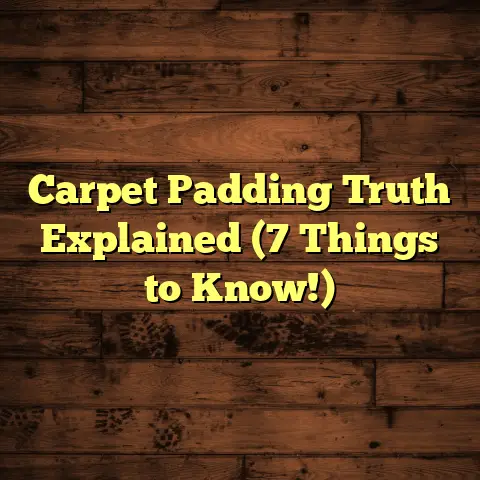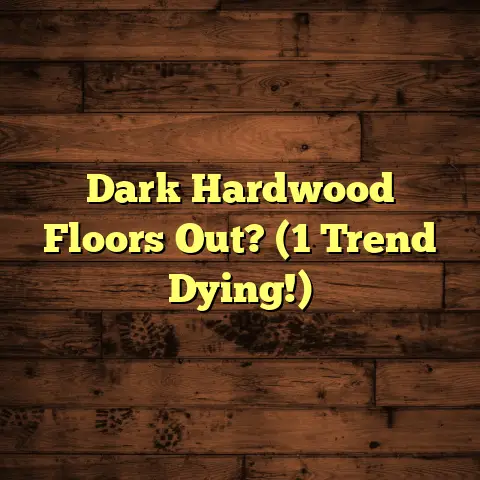What Is Concrete Design? (2 Finishes You’ll Love!)
Ever feel like you’re stuck in a flooring rut?
You know, that place where you’re tired of the same old options that either look drab or fall apart after a few years?
I get it. As a flooring contractor, I’ve seen countless homeowners struggle with this. They’re searching for that perfect blend of style and durability, especially in those high-traffic zones like kitchens, hallways, and even outdoors.
That’s where concrete design swoops in like a superhero! It’s an innovative solution that’s been transforming homes and businesses, offering both aesthetic appeal and incredible long-lasting performance.
Let’s dive in and explore the exciting world of concrete design and uncover two amazing finishes that might just be the answer to your flooring prayers.
Section 1: Understanding Concrete Design
So, what exactly is concrete design?
It’s more than just slapping down a gray slab. It’s about taking this versatile material and turning it into a stunning and functional element of your space. Think of it as sculpting with stone, but with a modern twist.
What is Concrete?
At its core, concrete is a composite material made up of:
- Cement: The binder that holds everything together.
- Aggregate: Usually sand, gravel, or crushed stone, providing the bulk of the mixture.
- Water: Essential for the chemical reaction (hydration) that hardens the concrete.
- Admixtures (Optional): These are added to modify certain properties, like workability, setting time, or durability.
The beauty of concrete lies in its moldability. When it’s wet, you can shape it into virtually any form.
Once it hardens, it becomes incredibly strong and durable. This makes it perfect for everything from foundations and walls to countertops and, of course, floors!
A Quick History Lesson
Believe it or not, concrete has been around for centuries! The Romans were masters of concrete construction, using it to build iconic structures like the Pantheon and the Colosseum. These buildings are still standing today, which is a testament to the material’s longevity.
Over the years, concrete technology has evolved significantly. We’ve developed new admixtures, reinforcement techniques, and finishing methods that allow us to create concrete structures that are stronger, more durable, and more aesthetically pleasing than ever before.
The Evolution of Concrete Design Techniques
Early concrete was pretty basic. Think utilitarian gray slabs. But today, the possibilities are endless!
We can now:
- Add Color: Integral pigments or stains can transform concrete into any hue imaginable.
- Create Textures: Stamping, etching, and other techniques allow us to mimic the look of natural stone, wood, or tile.
- Polish to a Shine: Polished concrete floors are sleek, modern, and incredibly durable.
- Incorporate Decorative Aggregates: Exposing colorful pebbles or glass chips adds visual interest.
The evolution of concrete design has been driven by both technological advancements and creative vision. Architects and designers are constantly pushing the boundaries of what’s possible, resulting in some truly stunning and innovative concrete applications.
Section 2: The Benefits of Concrete in Design
Okay, so we know what concrete design is. But why should you consider it for your next project? Let’s talk about the awesome benefits:
Durability and Strength: Built to Last
This is where concrete really shines. It’s incredibly strong and can withstand heavy use and abuse. I’ve seen concrete floors in warehouses that have held up under the weight of forklifts and heavy machinery for decades!
Unlike materials like wood or tile, concrete is resistant to:
- Impact: It won’t easily crack or chip.
- Abrasion: It can handle a lot of foot traffic.
- Moisture: It’s resistant to water damage, making it ideal for bathrooms, kitchens, and outdoor areas.
- Fire: Concrete is non-combustible, providing an extra layer of safety.
Low Maintenance: Less Work, More Enjoyment
Who wants to spend all their time cleaning and maintaining their floors? With concrete, you don’t have to!
Concrete surfaces are incredibly easy to care for. Regular sweeping and occasional mopping are usually all that’s needed.
Unlike carpet, concrete doesn’t harbor allergens or dust mites. And unlike wood, it doesn’t require periodic sanding and refinishing.
Versatility: The Sky’s the Limit
Concrete isn’t just for floors. It can be used in a wide range of applications, both indoors and outdoors:
- Countertops: Concrete countertops are durable, heat-resistant, and can be customized to match any design style.
- Walls: Concrete walls can add a modern, industrial feel to a space.
- Patios and Walkways: Stamped concrete is a popular choice for outdoor areas, as it can mimic the look of natural stone or brick at a fraction of the cost.
- Fireplaces: Concrete fireplaces are both functional and visually striking.
- Furniture: Concrete benches, tables, and even planters can add a unique touch to your home or garden.
Sustainability: An Eco-Friendly Choice
In today’s world, sustainability is more important than ever. Concrete can be a surprisingly eco-friendly material.
Here’s why:
- Recycled Materials: Concrete can incorporate recycled materials like fly ash (a byproduct of coal combustion) or slag (a byproduct of steel production). This reduces the amount of waste sent to landfills and conserves natural resources.
- Long Lifespan: Concrete’s durability means it doesn’t need to be replaced as often as other materials, reducing the environmental impact associated with manufacturing and disposal.
- Thermal Mass: Concrete has high thermal mass, meaning it can absorb and store heat. This can help to regulate indoor temperatures, reducing the need for heating and cooling. According to the Portland Cement Association, concrete homes can reduce energy consumption by up to 25% compared to wood-framed homes.
Section 3: Popular Concrete Finishes
Alright, now for the fun part! Let’s explore two concrete finishes that are both stylish and practical, and can solve those common flooring woes we talked about earlier.
Subsection 3.1: Polished Concrete Finish
What is Polished Concrete?
Polished concrete is exactly what it sounds like: concrete that has been mechanically ground, polished, and sealed to create a smooth, glossy surface.
The process involves using progressively finer diamond-impregnated pads to grind down the concrete surface, removing imperfections and revealing the aggregate beneath. The final step is to apply a sealant or hardener to protect the surface and enhance its shine.
Aesthetic Appeal and Applications
Polished concrete has a sleek, modern look that’s perfect for both residential and commercial spaces. It’s often used in:
- Lofts and Apartments: The minimalist aesthetic complements industrial-chic design styles.
- Retail Stores: The durable, easy-to-clean surface is ideal for high-traffic areas.
- Offices: The reflective quality can brighten up workspaces and create a more professional atmosphere.
- Restaurants and Bars: Polished concrete is resistant to spills and stains, making it a practical choice for food service environments.
- Homes: More and more homeowners are choosing polished concrete for their kitchens, living rooms, and even bedrooms.
Benefits of Polished Concrete
- Reflective Quality: Polished concrete reflects light, making spaces feel brighter and more open. This can reduce the need for artificial lighting, saving energy and money.
- Resistance to Stains and Spills: The dense, non-porous surface is resistant to stains and spills, making it easy to clean up messes.
- Customization Options: Polished concrete can be customized with different colors, patterns, and aggregate exposures to create a unique look. You can even embed objects like glass or metal into the concrete before it’s polished.
- Durability: Polished concrete is incredibly durable and can last for decades with proper maintenance.
- Cost-Effective: While the initial cost of polishing concrete may be higher than some other flooring options, its long lifespan and low maintenance requirements can make it a cost-effective choice in the long run.
Subsection 3.2: Stamped Concrete Finish
What is Stamped Concrete?
Stamped concrete, also known as patterned concrete, is a technique that involves imprinting textured patterns into freshly poured concrete before it hardens.
The patterns are created using rubber stamps that mimic the look of natural stone, brick, tile, wood, and other materials. Color hardeners and release agents are used to enhance the appearance and prevent the stamps from sticking to the concrete.
Creative Possibilities and Outdoor Applications
Stamped concrete is a great way to add visual interest and texture to outdoor spaces. It’s often used for:
- Patios: Create a beautiful and inviting outdoor living space.
- Walkways: Enhance the curb appeal of your home with a stamped concrete walkway.
- Driveways: Stamped concrete driveways are both durable and attractive.
- Pool Decks: Create a slip-resistant and visually appealing pool deck.
- Courtyards: Transform a plain courtyard into a stunning focal point.
Benefits of Stamped Concrete
- Cost-Effectiveness: Stamped concrete is typically less expensive than installing natural stone or brick.
- Customization Options: You can choose from a wide variety of patterns, colors, and textures to create a unique look that complements your landscaping and architectural style.
- Integration with Landscaping: Stamped concrete can be seamlessly integrated with your landscaping design, creating a cohesive and harmonious outdoor space.
- Durability: Stamped concrete is durable and can withstand the elements, making it a long-lasting choice for outdoor applications.
- Low Maintenance: Stamped concrete requires minimal maintenance. Regular sealing will help to protect the surface and prevent staining.
Section 4: Real-Life Examples and Applications
Let’s bring this all to life with some real-world examples!
Polished Concrete Success Story:
I recently worked on a project for a local coffee shop that wanted to create a modern, industrial vibe. They opted for polished concrete floors with a light gray stain. The result was stunning! The floors were not only beautiful but also incredibly easy to clean, which was a huge plus for a busy coffee shop. The owner told me that customers often commented on how much they loved the floors, and it really helped to create the atmosphere they were going for.
Stamped Concrete Transformation:
I also had a client who wanted to renovate their backyard patio. They were tired of the old, cracked concrete slab and wanted something that looked more inviting. We used stamped concrete to create a patio that resembled natural flagstone. The transformation was amazing! The patio looked like it belonged in a high-end resort, and the homeowners were thrilled with the results. They told me that they were spending much more time outdoors, enjoying their new and improved space.
These are just a couple of examples of how concrete design can transform spaces and solve common aesthetic and functional challenges. I’ve seen it time and time again, and it’s why I’m such a believer in the power of concrete.
Conclusion
So, there you have it! Concrete design is an innovative and stylish solution to many common flooring dilemmas.
Whether you’re looking for a sleek, modern look with polished concrete or a rustic, textured feel with stamped concrete, the possibilities are endless.
Don’t be afraid to think outside the box and explore the beauty and practicality of concrete finishes. They might just be the smart choice for your next design project!
What do you think? Ready to give concrete design a try? I’d love to hear your thoughts and answer any questions you might have. Let’s chat in the comments below!





